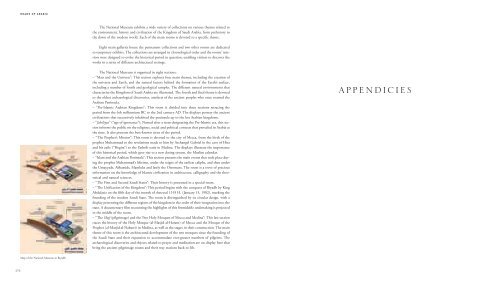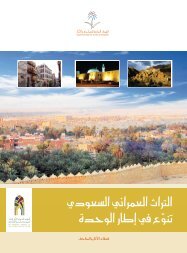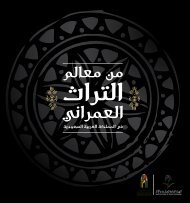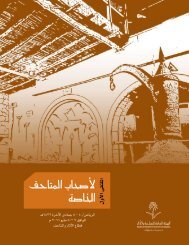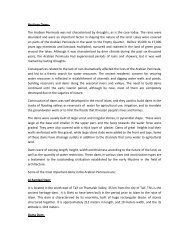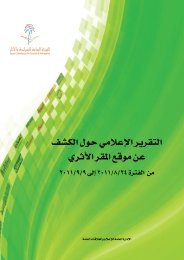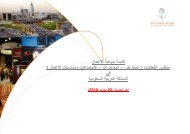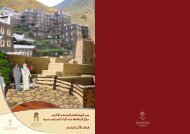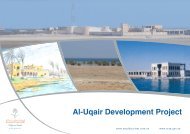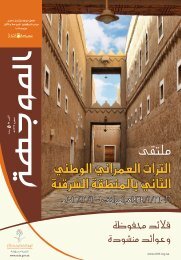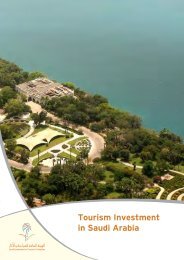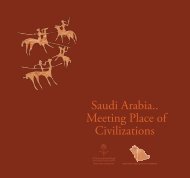37 Arabie Saoudite US_p574-577_BAT.qxd 23/06/10 21:22 Page 576 ROADS OF ARABIA The National Museum exhibits a wide variety <strong>of</strong> collections on various themes related to the environment, history and civilization <strong>of</strong> the Kingdom <strong>of</strong> Saudi <strong>Arabia</strong>, from prehistory to the dawn <strong>of</strong> the modern world. Each <strong>of</strong> the main rooms is devoted to a specific theme. Eight main galleries house the permanent collections and two other rooms are dedicated to temporary exhibits. The collections are arranged in chronological order and the rooms’ interiors were designed to evoke the historical period in question, enabling visitors to discover the works in a series <strong>of</strong> different architectural settings. The National Museum is organized in eight sections: – “Man and the Universe”: This section explores four main themes, including the creation <strong>of</strong> the universe and Earth, and the natural factors behind the formation <strong>of</strong> the Earth’s surface, including a number <strong>of</strong> fossils and geological samples. The different natural environments that characterize the Kingdom <strong>of</strong> Saudi <strong>Arabia</strong> are illustrated. The fourth and final theme is devoted to the oldest archaeological discoveries, artefacts <strong>of</strong> the ancient peoples who once roamed the <strong>Arabia</strong>n Peninsula. – “Pre-Islamic <strong>Arabia</strong>n Kingdoms”: This room is divided into three sections retracing the period from the 6th millennium BC to the 2nd century AD. The displays portray the ancient civilizations that successively inhabited the peninsula up to the last <strong>Arabia</strong>n kingdoms. – “Jahiliyya” (“age <strong>of</strong> ignorance”): Named after a term designating the Pre-Islamic era, this section informs the public on the religious, social and political contexts that prevailed in <strong>Arabia</strong> at the time. It also presents the best-known cities <strong>of</strong> the period. – “The Prophet’s Mission”: This room is devoted to the city <strong>of</strong> Mecca, from the birth <strong>of</strong> the prophet Muhammad to the revelations made to him by Archangel Gabriel in the cave <strong>of</strong> Hira and his exile (“Hegira”) to the Yathrib oasis in Medina. The displays illustrate the importance <strong>of</strong> this historical period, which gave rise to a new dating system, the Muslim calendar. – “Islam and the <strong>Arabia</strong>n Peninsula”: This section presents the main events that took place during the prophet Muhammad’s lifetime, under the reigns <strong>of</strong> the earliest caliphs, and then under the Umayyads, Abbassids, Mamluks and lastly the Ottomans. The room is a trove <strong>of</strong> precious information on the knowledge <strong>of</strong> Islamic civilization in architecture, calligraphy and the theoretical and natural sciences. – “The First and Second Saudi States”: Their history is presented in a special room. – “The Unification <strong>of</strong> the Kingdom”: This period begins with the conquest <strong>of</strong> Riyadh by King Abdulaziz on the fifth day <strong>of</strong> the month <strong>of</strong> shawwal 1319 H. (January 15, 1902), marking the founding <strong>of</strong> the modern Saudi State. The room is distinguished by its circular design, with a display presenting the different regions <strong>of</strong> the kingdom in the order <strong>of</strong> their integration into the state. A documentary film recounting the highlights <strong>of</strong> this formidable undertaking is projected in the middle <strong>of</strong> the room. – “The Hajj (pilgrimage) and the Two Holy Mosques <strong>of</strong> Mecca and Medina”: This last section traces the history <strong>of</strong> the Holy Mosque (al-Masjid al-Haram) <strong>of</strong> Mecca and the Mosque <strong>of</strong> the Prophet (al-Masjid al-Nabawi) in Medina, as well as the stages in their construction. The main theme <strong>of</strong> this room is the architectural development <strong>of</strong> the two mosques since the founding <strong>of</strong> the Saudi State and their expansion to accommodate ever-greater numbers <strong>of</strong> pilgrims. The archaeological discoveries and objects related to prayer and meditation are on display here that bring the ancient pilgrimage routes and their way stations back to life. APPENDICIES Map <strong>of</strong> the National Museum in Riyadh 576
38-Arabie US p578-608.qxd 23/06/10 21:25 Page 578 Aabit (god) 312, 315 al-‘Abbas (uncle <strong>of</strong> the Prophet) 434, 494, 507, 510, 570 Abbasids (the) 101, 108, 109, 114, 117, 238, 409, 410, 412, 416, 418, 426, 427, 428, 430, 434, 435, 437, 441, 443, 453, 454, 467, 476, 481, 482, 484, 485, 487, 494, 496, 499, 507, 523, 531, 532, 538, 548, 564, 574, 576 ‘Abd al-Malik ibn Marwan (Ummayad caliph) 116, 426, 430, 484 ‘Abd al-Muttalib (grandfather <strong>of</strong> the Prophet) 507, 501 ‘Abd Allah (father <strong>of</strong> the Prophet) 101 Abdaios 96, 376 Abdallah (shaykh) see Philby Abdulhamid I (Ottoman sultan) 456, 530, 576 Abdulhamid II (Ottoman sultan) 532, 575 Abdulmedjid I (sultan) 531, 549 Abi Harami al-Makki (the) 498, 499, 512, 514, 540 ‘Abd al-Rahman ibn Abi Harami al-Makki (stonecutter) 498, 499, 526 Ahmad ibn Abi Harami 498 Muhammad ibn Barakat ibn Abi Harami (stonecutter) 498 Muhammad ibn Salih ibn Abi Harami 498 Yahya Abi Harami 498 Abidistaras 376 Abiyatha‘ (king) 76, 77, 122, 381 Abraha (Himyarite king) 89, 90, 91, 93, 314 Abraham (prophet) 104, 106, 107, 211, 212, 213, 263, 548, 570 INDEX OF PROPER NAMES Entries in italics are the titles <strong>of</strong> written works or common nouns Abu Bakr (caliph) 111, 112, 113, 453, 516, 538, 549, 558, 567 Abu Dhar al-Ghifari (companion <strong>of</strong> the Prophet) 433, 436, 439 Abu Lahab (uncle <strong>of</strong> the Prophet) 105 Abu Numayy (sharif) 475 Abu Talib (uncle <strong>of</strong> the Prophet) 101, 508 Abu’l-Fida 47, 48 Abyssinians (the) 93, 314 Achaemenids (the) 221, 233, 378, 390, 562 Adad-guppi (priestess) see Hadad-happe ‘Adan 92 ‘Adi b. Zayd (poet) 130 Adiya (wife <strong>of</strong> Yautha‘) 76 ‘Adnan 86 Aelius Gallus (Roman general) 84, 85, 475 al-Afdal ‘Abbas (Rasulid sultan) 413 Agar (mother <strong>of</strong> Ishmael, servant <strong>of</strong> Abraham) 109, 548, 557, 570 Agatharchides <strong>of</strong> Cnidus 84, 96 Ahmad I (Ottoman sultan) 474, 531, 538, 540, 543, 544, 565 Ahmad III (Ahmed, Ottoman sultan) 538 Ahmad ibn ‘Isa al-Rada‘i see al-Rada‘i Aḥnikat (the) 319 Akbar (Great Mughal) 526 Akkoyunlu (the) 524, 527 Aksumites (the) 89, 90, 125, 126 Alexander the Great 81, 94, 111, 125, 376, 377, 379, 380, 381, 384, 390 ‘Ali (cousin <strong>of</strong> the Prophet and husband <strong>of</strong> Fatima, caliph) 109, 113, 409, 410, 433, 453, 494, 505, 508 ‘Ali Pasha 473 Ali Bey el-Abbassi 574 Alkaios (Alcaeus) <strong>of</strong> Mytilene 78 Allat (goddess) 93, 94, 98, 163, 327 Almaqah (god) 329 Al Saud (royal family) Abdallah ibn Faysal ibn Turki 582 Abdallah ibn Saud ibn ‘Abdulaziz ibn Muhammad ibn Saud 582 Abdulaziz ibn Abdulrahman Al Saud (called Ibn Saud, king) 38, 39, 51, 52, 239, 582, 583, 585, 586, 588, 589 Abdulrahman ibn Faysal ibn Turki 582 Faysal ibn Turki 582 Ibn Dir‘ 581 Mani‘ al-Muraydi 581 Mishari ibn Saud 582 Muhammad ibn Saud (emir) 50, 581, 582 Nasir ibn Saud 36 Saud ibn ‘Abdulaziz Muhammad ibn Saud 582 Saud ibn Faysal ibn Turki 582 Turki ibn ‘Abdallah ibn Muhammad ibn Saud 582 Ameer (or Amir, tribe) 92, 312, 330 See also Hanikain Amirain al-Amin (Abbasid caliph) 538 Ammi-leti <strong>of</strong> Napisu see Ammuladi Ammini-ilu (merchant) 76 Ammon 97 Ammuladi (shaykh) 76 ‘Amr (“king <strong>of</strong> all the Arabs”, father <strong>of</strong> Hujr) 85, 87 ‘Amr (son <strong>of</strong> Hujr) 87 ‘Amr (Salihid king) 88 ‘Amr (king <strong>of</strong> the tribe <strong>of</strong> Khazraj) 91 ‘Amr (the Nasrid) 91 ‘Amr ibn al-‘As 113 an-Nu‘man III (king) 131 Anbats (the) 212 Androsthenes 378 Andsu see Endios ‘Aniza 36, 457 Antigonus (Greek king) 98 Antimenidas (mercenary) 78 Antiochos III (Seleucid king) 96, 380, 381 Aphrodite (Greek goddess) 75, 400 Apis (Egyptian god) 233, 254 ’A‘ra (god) 298 Archais 378 Aretas IV (king) 85, 236, 287, 296, 303 Artaxerxes I (king <strong>of</strong> Persia) 221, 562 Artaxerxes II (king <strong>of</strong> Persia) 221, 562 Artemidorus 388, 389 Artemis (Greek goddess) 336, 343, 392 Arrien 378 Arwa (queen, daughter <strong>of</strong> Ahmad al-Sulayhi) 482 Ashima (divinity) 233, 562 Assarhaddon (king) 75, 76 Assurbanipal (king <strong>of</strong> Assyria) 75, 76, 220 Athena (Greek goddess) 236 ‘Athtar (god) 312, 315, 324 Auidisaros 376 ‘Awf (king) 88 Ayamu (Arab chief) 76, 77 Ayyubids (the) 238, 416, 456, 457, 458, 523, 553 al-‘Aziz (Fatimid caliph) 463 Azqir 93 Azraqi 492 Baha’ al-Din Ayaz (prince <strong>of</strong> Hormuz) 180 Bajadh 162 Bakr ibn Wa’il (tribe <strong>of</strong>) 87, 91, 585 al-Bakri 86, 131, 222, 366 Banu Ghifar (tribe) 434 Banu Hanifa (tribe) 581, 585 Banu Lihyan (tribe) 271, 272 Banu Murra b. ‘Awf (the) 91 Banu Qatada (the) 534 Banu Shayba 564, 565 Banu Yam (tribe) 366 Barakat II ibn Muhammad ibn Barakat (sharif <strong>of</strong> Mecca) 526 al-Barmaki, Muhammad ibn Khalid (governor) 482 Barquq (Mamluk sultan) 416, 419, 564 Barsbay (Mamluk sultan) 416, 473 Barsuna (king) 213 Baybars (Mamluk sultan) 408, 416, 471, 523 Bayezid II (Ottoman sultan) 524, 540 Baysaq (emir) 419 al-Bukhari 127 Belshazzar (son <strong>of</strong> Nabonidus) 77, 220 Burton, Richard Francis (explorer) 213, 553, 575 Cambyses (king <strong>of</strong> Persia) 221 Chadab (tribe) 399, 401 Chaldeans (the) 96, 125, 388, 389 Châtillon, Renaud de 417 410, 411, 417, 473, 475, 498, 519, 523, 525, 526, 527, 530, 531, 534, 564, 565, 574 Cleopatra (queen <strong>of</strong> Egypt) 84 Cyrus the Great (king <strong>of</strong> Persia) 77, 221 Dabr (the) 324 Dala’il al-khayrat (manuscript) 557, 558, 559, 571, 572 Darius I (king <strong>of</strong> Persia) 221, 562 David (prophet) 104 Dedanites (the) 212, 263, 264, 267, 268 dhu Ghabat (Lihyanite god) 266, 268, 272, 273, 274, 284, 315, 316 dhu l-Majaz 91 dhu l-Samawi (god) 93, 330, 370 dhu Nuwas (king) 89, 93 dhu Raydan 86, 311, 313, 332, 338 dhu Shara’ (Nabataean god) 84 Dhubyan 91 Dionysus (Greek god) 334 Doughty, Charles M. 51, 213, 222, 288 Dumah (tribe) 221 Endios 78 Eratosthenes <strong>of</strong> Cyrene (geographer) 96 Esimiphaios see Sumuyafa‘ Ashwa‘ Euting, Julius 51, 213, 222, 237, 562 Evi (king <strong>of</strong> Midian) 72, 213 ‘Ezana (negus) 128 Ezekiel (prophet) 82, 92, 263 Faraj (ibn Barquq, Mamluk sultan) 419, 564 Farouk (king <strong>of</strong> Egypt) 589 Al-Farra’ 434, 441 al-Fasi (Taqi al-Din al-Fasi al-Makki al-Maliki) 492, 494, 499, 516 Fatima (daughter <strong>of</strong> the Prophet) 109, 409, 410, 549, 550, 551, 566, 567, 568 Fatimids (the) 238, 408, 410, 411, 453, 454, 463, 467, 470, 476, 494, 496, 565 Faysal (king <strong>of</strong> Iraq) 588 al-Firuzabadi (linguist) 492 Flavius Josephus 72 Fresnel, Fulgence 50 Futuh al-haramayn (manuscript) 491, 547, 553, 555, 556, 566, 567, 568, 570 Gerrheans (the) 84, 96, 380, 381, 388 Geshem (Gusham) the Arab 98 al-Ghassani (tribe) 91, 493 Ghatham bint Oumrat ibn Tahiou 399, 401 Gideon (king <strong>of</strong> Israel) 72 Habab ibn Zayd 441 Habib’il Nawmat 378 Hadad-happe (Adad-guppi, mother <strong>of</strong> Nabonidus) 77, 220 hadith (the words and deeds <strong>of</strong> the Prophet) 433, 434, 440, 485, 486, 492 Hajj (pilgrimage) 38, 46, 408, 414, 427, 428, 456, 457, 479, 532, 547, 554, 558 al-Hajj al-Malik al Jukundar (Great Emir) 473 al-Hajjaj (governor <strong>of</strong> Iraq) 117, 484, 548 al-Hajjaj ibn Yusuf (Umayyad commander) 484 Hamadan (the) 366 al-Hamdani, Al-Hasan ibn Ahmad 135, 311, 454, 479, 482, 483, 484 Hammurabi (king <strong>of</strong> Babylon) 212 Hanikain Amirain (the) 312 han-Ilat (goddess) see al-Lat, allat al-Harawi 492 al-Harbi 454, 458, 479 al-Harith (son <strong>of</strong> Ka’b) 88, 90, 131 al-Harith (grandson <strong>of</strong> Hujr, king) 87 al-Harith (tribe) 93, 366 al-Harith b. Ka‘b (martyr) 93 Harithat (king <strong>of</strong> Hajar) 88, 94 Harpocrates (or Horus the Child, Egyptian god) 334, 335 Harun al-Rashid (Abbasid caliph) 409, 427, 428, 434, 435, 441, 484 Hasan (grandson <strong>of</strong> the Prophet) 109, 410, 505, 508 Hasan ‘Ali ibn ‘Isa (vizir) 418 Hasan ibn Ajlan (emir) 416 Hashemites (the) 101, 492, 505 Hashim (Banu/Bani) see Hashemites al-Hashimi (tribe) see Hashemites hatim 548, 556, 569, 570, 575 Hatte (the) 74 Haza’el (king <strong>of</strong> the Arabs) 75, 77 Helios (god) 96 Heracles 334, 381 Herbelot, Barthélemy d’ 46, 48 Herodotus 75, 132, 378 Hidhdharat 335 Hieron 378 hijr 108, 548 Himyarites (the) 50, 86, 87, 88, 89, 90, 122, 128, 314, 345, 362, 368 Hisham ibn ‘Abd al-Malik (Umayyad caliph) 86, 426, 454 Huber, Charles-Auguste 51, 213, 222, 562 Hujr (king <strong>of</strong> Kinda) 87 Hujrids (the) 87, 90 Hur (king <strong>of</strong> Midian) 72, 212 Husayn (grandson <strong>of</strong> the Prophet) 109, 410 Husayn ibn Salama (Ziyadid emir) 434, 481 578 579
- Page 1 and 2:
00 Arabie Saoudiens_p001-033_US.qxd
- Page 3 and 4:
00 Arabie Saoudiens_p001-033_US.qxd
- Page 5 and 6:
00 Arabie Saoudiens_p001-033_US.qxd
- Page 7 and 8:
00 Arabie Saoudiens_p001-033_US.qxd
- Page 9 and 10:
00 Arabie Saoudiens_p001-033_US.qxd
- Page 11 and 12:
00 Arabie Saoudiens_p001-033_US.qxd
- Page 13 and 14:
00 Arabie Saoudiens_p001-033_US.qxd
- Page 15 and 16:
00 Arabie Saoudiens_p001-033_US.qxd
- Page 17 and 18:
00 Arabie Saoudiens_p001-033_US.qxd
- Page 19 and 20:
01 Arabie_US_p034-043_BAT.qxd 23/06
- Page 21 and 22:
01 Arabie_US_p034-043_BAT.qxd 23/06
- Page 23 and 24:
02 Arabie US p044-053_BAT.qxd 23/06
- Page 25 and 26:
02 Arabie US p044-053_BAT.qxd 23/06
- Page 27 and 28:
02 Arabie US p044-053_BAT.qxd 23/06
- Page 29 and 30:
02bis (08) Arabie US p54-69_BAT.qxd
- Page 31 and 32:
02bis (08) Arabie US p54-69_BAT.qxd
- Page 33 and 34:
02bis (08) Arabie US p54-69_BAT.qxd
- Page 35 and 36:
02bis (08) Arabie US p54-69_BAT.qxd
- Page 37 and 38:
03 Arabie US p070-079_BAT.qxd 23/06
- Page 39 and 40:
03 Arabie US p070-079_BAT.qxd 23/06
- Page 41 and 42:
04 Arabie US_p080-99_BAT.qxd 23/06/
- Page 43 and 44:
04 Arabie US_p080-99_BAT.qxd 23/06/
- Page 45 and 46:
04 Arabie US_p080-99_BAT.qxd 23/06/
- Page 47 and 48:
04 Arabie US_p080-99_BAT.qxd 23/06/
- Page 49 and 50:
04 Arabie US_p080-99_BAT.qxd 23/06/
- Page 51 and 52:
05 Arabie US p100-109_CM_BAT.qxd 23
- Page 53 and 54:
05 Arabie US p100-109_CM_BAT.qxd 23
- Page 55 and 56:
05 Arabie US p100-109_CM_BAT.qxd 23
- Page 57 and 58:
06 Arabie US p110-117_BAT.qxd 23/06
- Page 59 and 60:
06 Arabie US p110-117_BAT.qxd 23/06
- Page 61 and 62:
07 Arabie US p118-131_BAT.qxd 23/06
- Page 63 and 64:
07 Arabie US p118-131_BAT.qxd 23/06
- Page 65 and 66:
07 Arabie US p118-131_BAT.qxd 23/06
- Page 67 and 68:
08bis Arabie US p132-135.qxd 23/06/
- Page 69 and 70:
09 Arabie US p136-157_CM_BAT.qxd 23
- Page 71 and 72:
09 Arabie US p136-157_CM_BAT.qxd 23
- Page 73 and 74:
09 Arabie US p136-157_CM_BAT.qxd 23
- Page 75 and 76:
09 Arabie US p136-157_CM_BAT.qxd 23
- Page 77 and 78:
09 Arabie US p136-157_CM_BAT.qxd 23
- Page 79 and 80:
09 Arabie US p136-157_CM_BAT.qxd 23
- Page 81 and 82:
10 Arabie US_p158-165_BAT.qxd 23/06
- Page 83 and 84:
10 Arabie US_p158-165_BAT.qxd 23/06
- Page 85 and 86:
11 Arabie US p166-169_CM_BAT.qxd 23
- Page 87 and 88:
12 Arabie US p170-207_CM_BAT.qxd 23
- Page 89 and 90:
12 Arabie US p170-207_CM_BAT.qxd 23
- Page 91 and 92:
12 Arabie US p170-207_CM_BAT.qxd 23
- Page 93 and 94:
12 Arabie US p170-207_CM_BAT.qxd 23
- Page 95 and 96:
12 Arabie US p170-207_CM_BAT.qxd 23
- Page 97 and 98:
12 Arabie US p170-207_CM_BAT.qxd 23
- Page 99 and 100:
12 Arabie US p170-207_CM_BAT.qxd 23
- Page 101 and 102:
12 Arabie US p170-207_CM_BAT.qxd 23
- Page 103 and 104:
12 Arabie US p170-207_CM_BAT.qxd 23
- Page 105 and 106:
13 Arabie US p208-217_BAT.qxd 23/06
- Page 107 and 108:
13 Arabie US p208-217_BAT.qxd 23/06
- Page 109 and 110:
13 Arabie US p208-217_BAT.qxd 23/06
- Page 111 and 112:
14 Arabie US_p218-261.qxd 23/06/10
- Page 113 and 114:
14 Arabie US_p218-261.qxd 23/06/10
- Page 115 and 116:
14 Arabie US_p218-261.qxd 23/06/10
- Page 117 and 118:
14 Arabie US_p218-261.qxd 23/06/10
- Page 119 and 120:
14 Arabie US_p218-261.qxd 23/06/10
- Page 121 and 122:
14 Arabie US_p218-261.qxd 23/06/10
- Page 123 and 124:
14 Arabie US_p218-261.qxd 23/06/10
- Page 125 and 126:
14 Arabie US_p218-261.qxd 23/06/10
- Page 127 and 128:
14 Arabie US_p218-261.qxd 23/06/10
- Page 129 and 130:
14 Arabie US_p218-261.qxd 23/06/10
- Page 131 and 132:
14 Arabie US_p218-261.qxd 23/06/10
- Page 133 and 134:
15 Arabie US_p262-269_BAT.qxd 23/06
- Page 135 and 136:
15 Arabie US_p262-269_BAT.qxd 23/06
- Page 137 and 138:
16 Arabie US p270-285_BAT.qxd 23/06
- Page 139 and 140:
16 Arabie US p270-285_BAT.qxd 23/06
- Page 141 and 142:
16 Arabie US p270-285_BAT.qxd 23/06
- Page 143 and 144:
16 Arabie US p270-285_BAT.qxd 23/06
- Page 145 and 146:
17 Arabie US p286-307.qxd 23/06/10
- Page 147 and 148:
17 Arabie US p286-307.qxd 23/06/10
- Page 149 and 150:
17 Arabie US p286-307.qxd 23/06/10
- Page 151 and 152:
17 Arabie US p286-307.qxd 23/06/10
- Page 153 and 154:
17 Arabie US p286-307.qxd 23/06/10
- Page 155 and 156:
18 Arabie US p308-317_BAT.qxd 23/06
- Page 157 and 158:
18 Arabie US p308-317_BAT.qxd 23/06
- Page 159 and 160:
18 Arabie US p308-317_BAT.qxd 23/06
- Page 161 and 162:
18bis Arabie US p318-363.qxd 23/06/
- Page 163 and 164:
18bis Arabie US p318-363.qxd 23/06/
- Page 165 and 166:
18bis Arabie US p318-363.qxd 23/06/
- Page 167 and 168:
18bis Arabie US p318-363.qxd 23/06/
- Page 169 and 170:
18bis Arabie US p318-363.qxd 23/06/
- Page 171 and 172:
18bis Arabie US p318-363.qxd 23/06/
- Page 173 and 174:
18bis Arabie US p318-363.qxd 23/06/
- Page 175 and 176:
18bis Arabie US p318-363.qxd 23/06/
- Page 177 and 178:
18bis Arabie US p318-363.qxd 23/06/
- Page 179 and 180:
18bis Arabie US p318-363.qxd 23/06/
- Page 181 and 182:
18bis Arabie US p318-363.qxd 23/06/
- Page 183 and 184:
19 Arabie US_p364-371_BAT.qxd 23/06
- Page 185 and 186:
19 Arabie US_p364-371_BAT.qxd 23/06
- Page 187 and 188:
20 Arabie US_p372-385_BAT.qxd 23/06
- Page 189 and 190:
20 Arabie US_p372-385_BAT.qxd 23/06
- Page 191 and 192:
20 Arabie US_p372-385_BAT.qxd 23/06
- Page 193 and 194:
20 Arabie US_p372-385_BAT.qxd 23/06
- Page 195 and 196:
20bis Arabie US p386-391_BAT.qxd 23
- Page 197 and 198:
21 Arabie US_p392-397_BAT.qxd 23/06
- Page 199 and 200:
21 Arabie US_p392-397_BAT.qxd 23/06
- Page 201 and 202:
22 Arabie US p398-403_BAT.qxd 23/06
- Page 203 and 204:
23 Arabie US p404-419_BAT.qxd 23/06
- Page 205 and 206:
23 Arabie US p404-419_BAT.qxd 23/06
- Page 207 and 208:
23 Arabie US p404-419_BAT.qxd 23/06
- Page 209 and 210:
23 Arabie US p404-419_BAT.qxd 23/06
- Page 211 and 212:
24 Arabie US p420-431_BAT.qxd 23/06
- Page 213 and 214:
24 Arabie US p420-431_BAT.qxd 23/06
- Page 215 and 216:
24 Arabie US p420-431_BAT.qxd 23/06
- Page 217 and 218:
25 Arabie US p432-441_BAT.qxd 23/06
- Page 219 and 220:
25 Arabie US p432-441_BAT.qxd 23/06
- Page 221 and 222:
25 Arabie US p432-441_BAT.qxd 23/06
- Page 223 and 224:
26 Arabie US_p442-451_BAT.qxd 23/06
- Page 225 and 226:
26 Arabie US_p442-451_BAT.qxd 23/06
- Page 227 and 228:
E A S M E D I T E R R A N E A N Jer
- Page 229 and 230:
ROADS OF ARABIA The Pilgrimage Road
- Page 231 and 232:
ROADS OF ARABIA al-Aqra‘ and al-H
- Page 233 and 234:
28 Arabie_ US_p462-469_BAT.qxd 23/0
- Page 235 and 236:
28 Arabie_ US_p462-469_BAT.qxd 23/0
- Page 237 and 238:
29 Arabie US p470-477_BAT.qxd 23/06
- Page 239 and 240: 29 Arabie US p470-477_BAT.qxd 23/06
- Page 241 and 242: 30 Arabie US_p478-485_BAT.qxd 23/06
- Page 243 and 244: 30 Arabie US_p478-485_BAT.qxd 23/06
- Page 245 and 246: 32 Arabie US p488-499_BAT.qxd 23/06
- Page 247 and 248: 32 Arabie US p488-499_BAT.qxd 23/06
- Page 249 and 250: 32 Arabie US p488-499_BAT.qxd 23/06
- Page 251 and 252: 32bis Arabie US p500-521_BAT.qxd 23
- Page 253 and 254: 32bis Arabie US p500-521_BAT.qxd 23
- Page 255 and 256: 32bis Arabie US p500-521_BAT.qxd 23
- Page 257 and 258: 32bis Arabie US p500-521_BAT.qxd 23
- Page 259 and 260: 32bis Arabie US p500-521_BAT.qxd 23
- Page 261 and 262: 32bis Arabie US p500-521_BAT.qxd 23
- Page 263 and 264: 34 Arabie US p522-545_BAT.qxd 23/06
- Page 265 and 266: 34 Arabie US p522-545_BAT.qxd 23/06
- Page 267 and 268: 34 Arabie US p522-545_BAT.qxd 23/06
- Page 269 and 270: 34 Arabie US p522-545_BAT.qxd 23/06
- Page 271 and 272: 34 Arabie US p522-545_BAT.qxd 23/06
- Page 273 and 274: 34 Arabie US p522-545_BAT.qxd 23/06
- Page 275 and 276: 35 Arabie US_p546-560_BAT.qxd 23/06
- Page 277 and 278: 35 Arabie US_p546-560_BAT.qxd 23/06
- Page 279 and 280: 35 Arabie US_p546-560_BAT.qxd 23/06
- Page 281 and 282: 35 Arabie US_p546-560_BAT.qxd 23/06
- Page 283 and 284: 36 Arabie Saoudite US p561-567_BAT.
- Page 285 and 286: 36 Arabie Saoudite US p561-567_BAT.
- Page 287 and 288: 36bis Arabie Saoudie US p568-573_BA
- Page 289: 37 Arabie Saoudite US_p574-577_BAT.
- Page 293 and 294: 38-Arabie US p578-608.qxd 23/06/10
- Page 295 and 296: 38-Arabie US p578-608.qxd 23/06/10
- Page 297 and 298: 38-Arabie US p578-608.qxd 23/06/10
- Page 299 and 300: 38-Arabie US p578-608.qxd 23/06/10
- Page 301 and 302: 38-Arabie US p578-608.qxd 23/06/10
- Page 303 and 304: 38-Arabie US p578-608.qxd 23/06/10
- Page 305 and 306: 38-Arabie US p578-608.qxd 23/06/10


